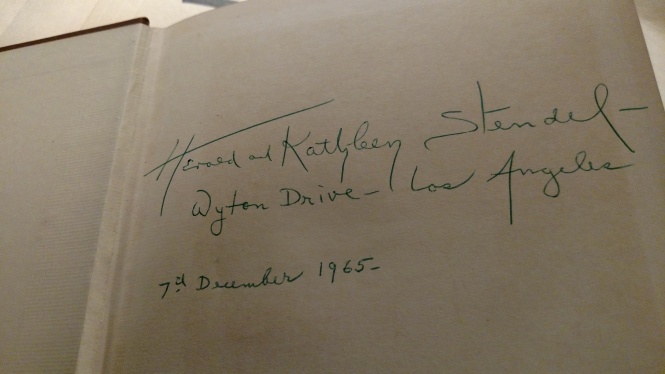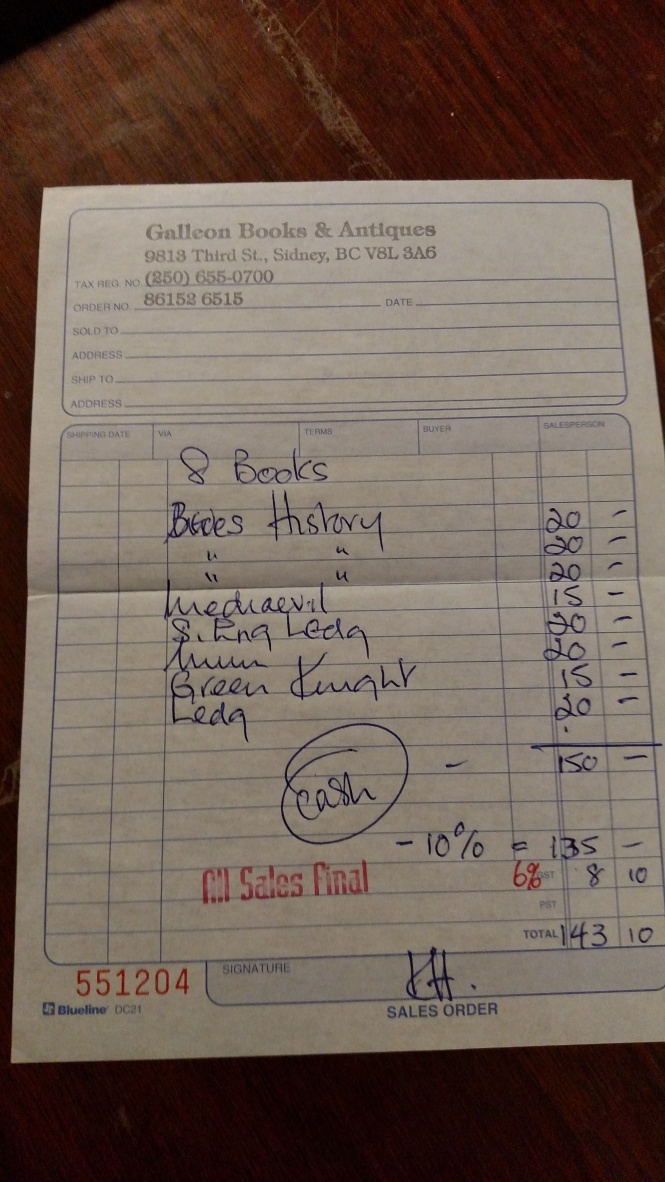The book I’m currently reading:

It’s fascinating. See my tweets for each day’s favorite find!
The book I’m currently reading:

It’s fascinating. See my tweets for each day’s favorite find!
So I bought a copy of the Early English Text Society edition of The South English Legendary:
 (Ever notice how you feel smarter already when you buy a book that comes in multiple volumes, the last of which is exclusively notes and commentary?)
(Ever notice how you feel smarter already when you buy a book that comes in multiple volumes, the last of which is exclusively notes and commentary?)
What is even cooler than the book(s) is that the set arrived with its own history tucked inside. The inscription of the original owners:

Okay, fine, I hear you, lot of books have their first (and sometimes subsequent) owners’ names written inside. Tough crowd.
But then there was this:

A letter from the EETS editor, to the original purchaser, and mentioning the Kennedy assassination. Complete with coffee mug stains from either sender or receiver.
And then:
 The bill of sale from when the set was bought used, having somehow made its way to British Columbia from Los Angeles.
The bill of sale from when the set was bought used, having somehow made its way to British Columbia from Los Angeles.
Not to mention the bill of sale I was actually expecting: 
(Close-eyed observers will note that this set had misplaced volume 3, no doubt on the hard trek to British Columbia. I ordered it separately.)
Either the owner(s) have an unusual commitment to history, keeping the sales receipts with the book(s), or this is a book that tends to be purchased more than read.
Weelll, it is a collection of edifying saints’ lives. Make up your own minds. Could go either way.
I know, I know, the Black Death was a medieval phenomenon.
Yes.
And no.
It comes back every so often. Like here. The difference, of course, between modern inconvenience and medieval catastrophe is antibiotics.
This knife is recent discovery. I expect the interpretation of the inscription is accurate, but if I were using putting it in a story, I’d be tempted to have the ‘real’ meaning so more like, ‘when I kill you, I pray for your soul to go to heaven.’
Learned everything you need to know about how the middle ages handled wrong-doers from Hollywood? A terse but on-target corrective.
Wait, we’ve found another area in which the middle ages were way more sophisticated and advanced than we’ve been led to believe? Imagine my shock.
Hilariously accurate not historically accurate…Craig Ferguson explains literacy in the middle ages. And medieval road rage. From a stage show, so the swear words are still there. Plan accordingly.
And then he visits a Medieval Times restaurant. From his TV show, so the four-letter decoratives are bleeped.
Cause who doesn’t want a song about the Black Death?
You’re welcome.
Congrats and thanks to the clever creators of this song/video.
Out of the East: Spices and the Medieval Imagination. Paul Freedman. Yale University Press, 2008.
This was an impulse purchase, one of those books that leap at me from the rows and rows of vendors at Kalamazoo, beg to come home, and then languish unread as I foolishly attempt to get real work done.
Fortunately, this one escaped the pile. One of the most fabulous things about being a medievalist is that you can spend a decade in grad school, keep reading in the decade since you finished your degree, and still pick up a book that teaches you all sorts of cool stuff about your time period. Among them:
1. Despite (or perhaps because of) their costliness, spices were used as much and as often as people could afford to do so.
2. Medieval (that is, the high Middle Ages–this book deals with the 12th – 15th centuries) taste in food was exotic and complex, closer to modern middle eastern cooking than what we stereotypically think of as ‘medieval’ (plain, bland). I already knew medieval people preferred complicated, show-off dishes for feasts, but this book argues it’s a more widespread phenomena. Having to settle for an unadorned, and mostly vegetable rather than meat-based, diet was a mark of your poor social status, as were dairy products and sausages. Also uncooked fruit was suspected to be seriously bad for you.
3. Moreover, the spices used tend to be, well, spicy–cinnamon, ginger, saffron, cloves, nutmeg, mace, galangal, grains of paradise, black pepper.
4. Sugar was considered a spice. It was just as costly and rare as the others. (Actually, I did know that but I include it here since it’s an important point that I suspect most folks won’t already be aware of.) In Elizabethan English the average per capita consumption of sugar was about a pound. (For comparison, in the US now it’s 126 lbs.)
5. The use of spices was connected to the humor theory of the body. That is, spices were used in a drug-like way, their properties offsetting those of the humors a people finds currently out of balance.
6. Spices were also connected to the earthly paradise, believed for a long time to actually come from it, carrying the literal aroma of sanctity with them. Relatedly, the smell of spices was just as important an element of their function as taste..
7. Late medieval exploration was spurred in part by a desire to find a more direct route to the source of spice and get rich selling them back home.
8. People begun to eat salads as we know them in the 17th century as part of a French rejection of medieval complex cookery, embracing the idea of food tasting like what it is, a surprisingly revolutionary concept.
9. The complex web of connotations around spices meant they simultaneously ccupied space both as objects of conspicuous consumption and as an accepted, healthful choice. (Sort of like Whole Food, I suppose.)
10. Black pepper is the only commonly-used medieval spice to continue as a commonly-used spice in the post-medieval world, although elements of medieval cooking spices survive in holiday baking, although most of those dishes derive from Victorian attempts to emulate the middle ages rather than being actually medieval.
An added bonus of the book in the author’s ranting on more than one occasion about how spices were NOT used to cover up the taste of spoiled meat. It’s always nice to see other medievalists foaming at the mouth about the dreadful lies that just won’t die.
You must be logged in to post a comment.